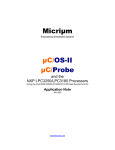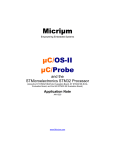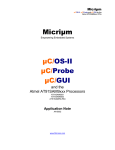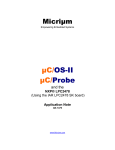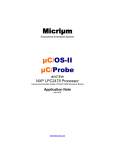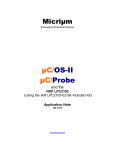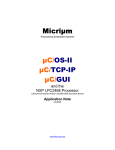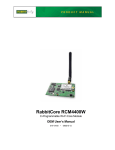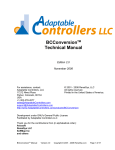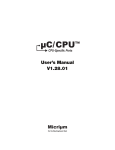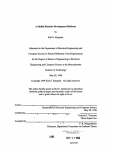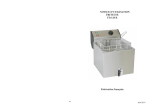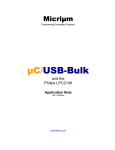Download OSs-Micrium-Learning Centre-Application Notes
Transcript
Micriµm
µC/OS-II and µC/Probe for the
NXP LPC17xx CPUs
Micriµm
Empowering Embedded Systems
μC/OS-II
μC/Probe
and the
NXP LPC17xx Processors
on the IAR LPC1768-SK development Board
Application Note
AN-1080
www.Micrium.com
Micriµm
µC/OS-II and µC/Probe for the
NXP LPC1768-SK CPUs
About Micriµm
Micriµm provides high-quality embedded software components in the industry by way of engineer-friendly
source code, unsurpassed documentation, and customer support. The company‟s world-renowned realtime operating system, the Micriµm µC/OS-II, features the highest-quality source code available for
today's embedded market. Micriµm delivers to the embedded marketplace a full portfolio of embedded
software components that complement µC/OS-II. A TCP/IP stack, USB stack, CAN stack, File System
(FS), Graphical User Interface (GUI), as well as many other high quality embedded components.
Micriµm‟s products consistently shorten time-to-market throughout all product development cycles. For
additional information on Micriµm, please visit www.micrium.com.
About µC/OS-II
Thank you for your interest in µC/OS-II. µC/OS-II is a preemptive, real-time, multitasking kernel.
µC/OS-II has been ported to over 45 different CPU architectures and now, has been ported to the NXP
LPC17xx processors
µC/OS-II is small yet provides all the services you would expect from an RTOS: task management, time
and timer management, semaphore and mutex, message mailboxes and queues, event flags a much
more.
You will find that µC/OS-II delivers on all your expectations and you will be pleased by its ease of use.
Licensing
µC/OS-II is provided in source form for FREE evaluation, for educational use or for peaceful research. If
you plan on using µC/OS-II in a commercial product you need to contact Micriµm to properly license its
use in your product. We provide ALL the source code with this application note for your convenience and
to help you experience µC/OS-II. The fact that the source is provided DOES NOT mean that you can
use it without paying a licensing fee. Please help us continue to provide the Embedded community with
the finest software available. Your honesty is greatly appreciated.
2
Micriµm
µC/OS-II and µC/Probe for the
NXP LPC1768-SK CPUs
About µC/Probe
μC/Probe is a Windows application that allows a user to display the value (at run-time) of virtually any
variable or memory location on a connected embedded target. The user simply populates μC/Probe‟s
graphical environment with gauges, tables, graphs, and other components, and associates each of these
with a variable or memory location. Once the application is loaded onto the target, the user can begin
μC/Probe‟s data collection, which will update the screen with variable values fetched from the target.
μC/Probe retrieves the values of global variables from a connected embedded target and displays the
values in an engineer-friendly format. The supported data-types are: booleans, integers, floats and ASCII
strings.
μC/Probe can have any number of „data screens‟ where these variables are displayed. This allows to
logically group different „views‟ into a product.
A 30-day trial version of μC/Probe is available on the Micriµm website:
http://www.micrium.com/products/probe/probe.html
3
Micriµm
µC/OS-II and µC/Probe for the
NXP LPC1768-SK CPUs
Manual Version
If you find any errors in this document, please inform us and we will make the appropriate corrections for
future releases.
Version
Date
By
Description
V.1.00
2009/09/19
FT
Initial version.
Software Versions
This document may or may not have been downloaded as part of an executable file, Micrium-NXP-uCOSII-LPC1768-SK.exe, containing the code and projects described here. If so, then the versions of the
Micriµm software modules in the table below would be included. In either case, the software port
described in this document uses the module versions in the table below
Module
Version
μC/OS-II
V2.89
μC/Probe
V2.3
Comment
See Also
In addition to the µC/OS-II, µC/FS, µC/USB-Device, µC/USB-Host, µC/USB-OTG, µC/TCP-IP
have been ported to the LPC17xx processors.
4
Micriµm
µC/OS-II and µC/Probe for the
NXP LPC1768-SK CPUs
Document Conventions
Numbers and Number Bases
Hexadecimal numbers are preceded by the “0x” prefix and displayed in a monospaced font.
Example: 0xFF886633.
Binary numbers are followed by the suffix “b”; for longer numbers, groups of four digits are
separated with a space. These are also displayed in a monospaced font. Example: 0101 1010
0011 1100b.
Other numbers in the document are decimal.
prevailing where the number is used.
These are displayed in the proportional font
Typographical Conventions
Hexadecimal and binary numbers are displayed in a monospaced font.
Code excerpts, variable names, and function names are displayed in a monospaced font.
Functions names are always followed by empty parentheses (e.g., OS_Start()). Array names
are always followed by empty square brackets (e.g., BSP_Vector_Array[]).
File and directory names are always displayed in an italicized serif font.
/Micrium/Sofware/uCOS-II/Source/.
Example:
A bold style may be layered on any of the preceding conventions—or in ordinary text—to more
strongly emphasize a particular detail.
Any other text is displayed in a sans-serif font.
5
Micriµm
µC/OS-II and µC/Probe for the
NXP LPC1768-SK CPUs
Table of Contents
1.
1.01
1.02
1.03
1.03.01
1.03.02
1.03.03
1.04
Getting Started.
Installing the Micirum Software
Setting up the Hardware
Opening the Examples Projects
IAR Example Project
IAR µC/OS-II Kernel Awareness.
IAR Project Options
Running the Example Applications
7
7
8
8
8
9
10
10
2.
Directories and Files
12
3.
3.01
3.02
Application Code
app.c
os_cfg.h
16
16
19
4
4.01
4.02
4.03
Board Support Package (BSP)
BSP, bsp_xxx.c and bsp_xxx.h files
Board Support Package Configuration
Tick Interrupt code.
20
20
21
21
5.
μC/Probe
22
Licensing
References
Contacts
25
25
25
6
Micriµm
µC/OS-II and µC/Probe for the
NXP LPC1768-SK CPUs
1. Getting Started.
The following sections step trough the prerequisites for using the demonstration application described in
this document, AN-1080. First, installation of software and the setup of the hardware will be outlined.
Second, the use and setup of the IAR embedded Workbench. Thirdly, the steps to build the projects and
load the application onto the board trough JTAG will be described. Lastly, instructions will be provided for
using the example application.
1.01 Installing the Micirum Software
The source code for µC/OS-II is provided in source form along with IAR Embedded Workbench for ARM
project files that allow you to run µC/OS-II on the IAR LPC1768-SK development board. To install the
software, simply run the self-extracting executable. Micrium-NXP-uCOS-II-LPC1768-SK.exe.
You will be prompted to accept the simple terms of the licensing agreement. If you answer „Yes‟, the
software will be installed on your PC under the \Micrium directory from the root as shown in Figure 1-1
Licensing agreements
(If µC/OS-II is used
commercially)
Contact
www.Micrium.com
for pricing
\Micrium
\AppNotes
\AN1xxx-RTOS
\AN1018-uCOS-II-Cortex-M3
\AN1080-uCOS-II-NXP-LPC1768-SK
\AN9xxx-MULT
\AN-9913-PROBE-DEMO-INTRO
AN-1080
AN-9913
\Licensing
\Software
\EvalBoards
\NXP
\LPC1768-SK
\IAR
\BSP
\OS-Probe
\uC-CPU
\ARM-Cortex-M3
\IAR
\Doc
µC/OS-II
The Real Time
Kernel
µC/OS-II
documentation
AN-1018
\uC-LIB
\Doc
\Ports
\ARM-Cortex-M3
\IAR
\uCOS-II
\Doc
\Ports
\ARM-Cortex-M3
\Generic
\IAR
\Source
7
LPC1768-SK Board
Support Package
LPC1768 IAR example
project
ARM Cortex M3
µC/OS-II port
µC/OS-II processor
independent source
code
Micriµm
µC/OS-II and µC/Probe for the
NXP LPC1768-SK CPUs
Target
Communication
RS-232
Communication
µC/Probe
µC/OS-II Plug-in
\uC-Probe
µC/Probe
\Target
Real-Time Monitor
\Communication
\DCC
\Generic
\OS
\RS-232
\Ports
\NXP
\LPC17xx
\Source
\Source
µC/Probe
\Workspace
RS232 LPC17xx
\Demos
Ports
\Intro
\Source
\Workspaces
\Plugins
\uCOS-II
Figure 1-1. Directory Structure
1.02
Setting up the Hardware
The processor can be programmed and debugged trough the 20-pin JTAG port using a JTAG emulator,
such as J-Link.
The board can be power up from a standard 5v DC converter, J-Link or the USB connector.
The Power select jumper (PWR_SEL) will determine the power supply used.
To use µC/Probe with the LPC1768-SK, download and install the trial version of the program from the
Micrium website as discussed in section 5. After programming your target with one of the included
projects, connect a RS-232 cable between the board and your PC, configure RS-232 options, and start
running the program.
1.03
Opening the Examples Projects
1.03.01 IAR Example Project
To view the IAR example project, start an instance of IAR Embedded Workbench, and open:
LPC1768--OS-Probe.ewp, located in
/Micrium/Software/EvalBoards/NXP/LPC1768-SK /IAR/OS-Probe folder.
To do this, use the Add Existing Project... menu command under the Project menu:
8
Micriµm
µC/OS-II and µC/Probe for the
NXP LPC1768-SK CPUs
Figure 1-2. IAR EW. Opening an existing project
IAR EWARM Versions
Be certain to open the proper project for your version of EWARM. The NXP LPC1768
examples project was built using EWARM ver. 5.4
1.03.02 IAR µC/OS-II Kernel Awareness.
The µC/OS-II Kernel Awareness plug-in will allow you to examine information about system objects while
using the C-Spy debugger. To gain access to this feature, enable the plug-in by right-clicking on the
project name in the work space browser and choosing Options… Then, select the “Debugger” entry in the
list box, and the “Plug-in” tab pane. Find the µC/OS-II entry in the list and, finally, select the check box
beside the entry. Make sure you select the correct plug-in for the correct version of µC/OS-II.
“uC/OS-II for version 2.86 and earlier” for µC/OS-II version 2.86 and earlier
“uC/OS-II” for µC/OS-II version 2.87 and above.
9
Micriµm
µC/OS-II and µC/Probe for the
NXP LPC1768-SK CPUs
Figure 1-3. Enabling the μC/OS-II Kernel Awareness Plug-In
1.03.03 IAR Project Options
The IAR project configurations allow you to compile, link and load the software in different ways to the
target. The following configuration is available in the IAR project.
FLASH: This project option is configured to load the code into the Internal 256Kb Internal Flash.
1.04
Running the Example Applications
The example project includes a basic demonstration of μC/OS-II and μC/Probe. The evaluation board
components are labeled in the figure 1-4
Once the program is loaded onto the target, the LEDs will start blinking.
The system state will be output to the color LCD display, the joystick (toggle left/right) can be used to
move the output to a new item.
10
Micriµm
µC/OS-II and µC/Probe for the
NXP LPC1768-SK CPUs
JTA connector
Color LCD
Nokia 6610
USB OTG port
µC/OTG
USB Host Port
µC/USB-Host
RS-232 for
µC/Probe
Application
Output
USB Device Port
µC/USB-Device
User’s LEDs
User’s Push
Buttons
High Speed
SDCard interface
µC/FS
User’s Push
Joystick
Figure 1-4. IAR LPC1768-SK Development Board
The RS232 port labeled “RS232 for µC/Probe” is used for µC/Probe (at 115200 baud), which allows
you to view (in real-time) the value of any variables in the target system.
11
Micriµm
µC/OS-II and µC/Probe for the
NXP LPC1768-SK CPUs
2.
Directories and Files
Application Notes
\Micrium\AppNotes\AN1xxx-RTOS\AN1018-uCOS-II-Cortex-M3
This directory contains AN-1018.pdf, the application note describing the ARM-Cortex-M3 port for
μC/OS-II.
\Micrium\AppNotes\AN1xxx-RTOS\AN1080--uCOS-II-NXP-LPC1768-SK
This directory contains this application note, AN-1080.pdf.
\Micrium\AppNotes\AN9xxx-MULT\AN-9913-PROBE-DEMO-INTRO
This directory contains this application note, AN-9913.pdf describing the introductory demo for
μC/Probe
Licensing Information
\Micrium\Licensing
Licensing agreements are located in this directory. Any source code accompanying this appnote
is provided for evaluation purposes only. If you choose to use μC/OS-II in a commercial product,
you must contact Micriμm regarding the necessary licensing.
μC/OS-II Files
\Micrium\Software\uCOS-II\Doc
This directory contains documentation for μC/OS-II.
\Micrium\Software\uCOS-II\Ports\ARM\Generic\IAR
This directory contains the standard processor-specific files for the generic μC/OS-II ARM port
assuming the IAR toolchain. These files could easily be modified to work with other toolchains
(i.e., compiler/assembler/linker/locator/debugger); however, the modified files should be placed
into a different directory. The following files are in this directory:
os_cpu.h
os_cpu_a.asm
os_cpu_c.c
os_dcc.c
os_dbg.c
With this port, μC/OS-II can be used in either ARM or Thumb mode. Thumb mode, which
drastically reduces the size of the code, was used in this example, but compiler settings may be
switched (as discussed in Section 2.30) to generate ARM-mode code without needing to change
either the port or the application code. The ARM/Thumb port is described in application note AN1014 which is available from the Micrium web site.
\Micrium\Software\uCOS-II\Source
This directory contains the processor-independent source code for μC/OS-II.
12
Micriµm
µC/OS-II and µC/Probe for the
NXP LPC1768-SK CPUs
μC/Probe Files
\Micrium\Software\uC-Probe\Communication\Generic\
This directory contains the μC/Probe generic communication module, the target-side code
responsible for responding to requests from the μC/Probe Windows application (including
requests over RS-232).
\Micrium\Software\uC-Probe\Communication\Generic\Source
This directory contains probe_com.c and probe_com.h, the source code for the generic
communication module.
\Micrium\Software\uC-Probe\Communication\Generic\OS\uCOS-II
This directory contains probe_com_os.c, which is the μC/OS-II port for the μC/Probe generic
communication module.
\Micrium\Software\uC-Probe\Communication\Generic\Source\RS-232
This directory contains the RS-232 specific code for μC/Probe generic communication module,
the target-side code responsible for responding to requests from the μC/Probe Windows
application over RS-232
\Micrium\Software\uC-Probe\Communication\Generic\Source\RS-232\Source
This directory contains probe_rs232.c and probe_rs232.h, the source code for the generic
communication module RS-232 code.
\Micrium\Software\uC-Probe\Communication\Generic\Source\RS-232\Ports\NXP\LPC17xx
These directories contain probe_rs232c.c and probe_rs232c.h, the NXP LPC17xx port for the RS232 communications.
\Micrium\Software\uC-Probe\Communication\Generic\Source\RS-232\OS\uCOS-II
This directory contains probe_rs232_os.c, which is the μC/OS-II port for the μC/Probe RS-232
communication module.
\Micrium\Software\uC-Probe\Demos\Intro\Source\
This directory contains probe_demo_intro.c, which contains a self-explanatory introductory demo
showing how to use μC/Probe (consult the application note AN-9913)
μC/CPU Files
\Micrium\Software\uC-CPU
This directory contains cpu_def.h, which declares #define constants for CPU alignment,
endianness, and other generic CPU properties.
\Micrium\Software\uC-CPU\ARM\IAR
This directory contains cpu.h and cpu_a.s. cpu.h defines the Micriμm portable data types for 8-,
16-, and 32-bit signed and unsigned integers (such as CPU_INT16U, a 16-bit unsigned integer).
These allow code to be independent of processor and compiler word size definitions. cpu_a.s
contains generic assembly code for ARM7 and ARM9 processors which is used to enable and
disable interrupts within the operating system.
This code is called from C with
OS_ENTER_CRITICAL() and OS_EXIT_CRITICAL().
13
Micriµm
µC/OS-II and µC/Probe for the
NXP LPC1768-SK CPUs
μC/LIB Files
\Micrium\Software\uC-LIB
This directory contains lib_def.h, which provides #defines for useful constants (like DEF_TRUE
and DEF_DISABLED) and macros.
The files lib_mem.c and lib_mem.h contain code to replace the standard library functions
memclr(), memset(), memcopy() and memcmp(). These functions are replaced by
Mem_Clr(), Mem_Set(), Mem_Copy() and Mem_Cmp(), respectively.
The files lib_str.c and lib_str.h contain code to replace the standard library functions str???(),
with the equivalent Str_???() functions.
The files lib_str.c and lib_str.h contain code to replace the standard library functions str???(),
with the equivalent Str_???() functions.
The files lib_ascii.c and lib_ascii.h contain code to replace the standard library character
classification and case conversion functions & macros such as tolower(), toupper(),
isalpha(), isdigit(), etc. These functions are replaced with ASCII_ToLower(),
ASCII_ToUpper(), ASCII_IsAlpha()and ASCII_IsDig().
The files lib_math.c and lib_math.h contain code to replace the standard mathematics functions
such as rand(), srand(), etc. These functions are replaced with Math_Rand(),
Math_RandSetSeed().
The reason Micium declare its own function of for third party certification for avionics and medical
use
\Micrium\Software\uC-LIB\Doc
This directory contains the documentation for μC/LIB.
Application Code
\Micrium\Software\EvalBoards\NXP\LPC1768-SK\IAR\OS-Probe
This directory contains the source code the example application:
app.c contains the test code for the example application including calls to the functions
that start multitasking within μC/OS-II, register tasks with the kernel, and update the user
interface (the LEDs and the push buttons).
app_cfg.h is a configuration file specifying stack sizes and priorities for all user tasks and
#defines for important global application constants.
app_probe.c/h contain code to initialize μC/Probe,
app_hooks.c/h contain code for the μC/OS-II application hooks.
app_vect.c contain the initialization code for the NXP LPC17xx processor
includes.h is the master include file used by the application.
14
Micriµm
µC/OS-II and µC/Probe for the
NXP LPC1768-SK CPUs
os_cfg.h is the μC/OS-II configuration file.
cpu_cfg.h is the μC/CPU configuration file.
probe_com_cfg.h is the μC/Probe configuration file.
LPC1768-OS-Probe.* are the IAR Embedded Workbench project files for the IAR
LPC1768-SK board.
\Micrium\Software\EvalBoards\NXP\LPC1768 \IAR\BSP
This directory contains the Board Support Package and chip support package for the IAR
LPC1768-SK development board and LPC1768 processor.
bsp.c /h contain generic BSP functions which initialize critical processor functions (e.g., the
PLL) and provide support for peripherals such as the push button and LEDs.
bsp_int.c/h contain routines to install ISRs and enable/disable interrupt sources.
bsp_pmc.c/h Contain basic function to enable, disable and retrieve clock frequency
information from the peripheral and system clocks.
bsp_ser.c/h Provide simple serial interface for tracing functionality.
bsp_gpio.c/h Contain basic functionality to configure and manipulate I/Os pins.
15
Micriµm
µC/OS-II and µC/Probe for the
NXP LPC1768-SK CPUs
3.
Application Code
The example application described in this appnote, AN-1080, is a simple demonstration of μC/OS-II and
μC/OS-Probe for the NXP LPC1768 processors on the IAR LPC1768-SK developments board.
3.01
app.c
Four functions of interest are located in app.c:
1. main() is the entry point for the application, as it is with most C programs. This function
initializes the operating system, creates the primary application task, App_TaskStart(), begins
multitasking, and exits.
2. App_TaskStart(), after creating the application events and tasks, enters an infinite loop in
which it blinks the LEDs.
3. App_TaskKbd()polls the user inputs—Board‟s Joystick—and, if new input is detected, places a
message in a mailbox for App_TaskUserIF().
4. App_TaskUserIF(),Outputs the state of the system based on the display state passed to it by
App_TaskKbd().
16
Micriµm
µC/OS-II and µC/Probe for the
NXP LPC1768-SK CPUs
int main (void)
{
#if (OS_TASK_NAME_EN > 0)
CPU_INT08U err;
#endif
#if (CPU_CFG_NAME_EN == DEF_ENABLED)
CPU_ERR
cpu_err;
#endif
/* Note 1 */
CPU_Init();
/* Note 2 */
#if (CPU_CFG_NAME_EN == DEF_ENABLED)
CPU_NameSet((CPU_CHAR *)"LPC1768",
(CPU_ERR *)&cpu_err);
#endif
CPU_IntDis();
/* Note 3 */
OSInit();
/* Note 4 */
OSTaskCreateExt((void (*)(void *)) App_TaskStart,
/* Note 5 */
(void
*) 0,
(OS_STK
*)&AppTaskStartStk[APP_CFG_TASK_START_STK_SIZE - 1],
(INT8U
) APP_CFG_TASK_START_PRIO,
(INT16U
) APP_CFG_TASK_START_PRIO,
(OS_STK
*)&AppTaskStartStk[0],
(INT32U
) APP_CFG_TASK_START_STK_SIZE,
(void
*) 0,
(INT8U
)(OS_TASK_OPT_STK_CHK | OS_TASK_OPT_STK_CLR));
#if (OS_TASK_NAME_EN > 0)
/* Note 6 */
OSTaskNameSet(APP_CFG_TASK_START_PRIO, (CPU_INT08U *)"Startup", &err);
#endif
OSStart();
/* Note 7 */
return (1);
}
Listing 3-1, main()
Listing 3-1, Note 1: As with most C applications, the code starts in main().
Listing 3-1, Note 2: CPU_Init() initialize the μC/CPU module. CPU_NameSet() set the CPU Host
Name
Listing 3-1, Note 3: CPU_IntDis() Disable all the interrupts. All interrupts are disabled to make sure
the application does not get interrupted until is fully initialized.
Listing 3-1, Note 4: OSInit() must be called before creating a task or any other kernel object, as must
be done with all μC/OS-II applications.
Listing 3-1, Note 5: At least one task must be created (in this case, using OSTaskCreateExt() to
obtain additional information about the task). In addition, μC/OS-II creates either one or two
internal tasks in OSInit(). μC/OS-II always creates an idle task, OS_TaskIdle(), and will
create a statistic task, OS_TaskStat() if you set OS_TASK_STAT_EN to 1 in os_cfg.h.
Listing 3-1, Note 6: You can name μC/OS-II tasks (and other kernel objects) and display task names at
run-time or with a debugger. In this case, the App_TaskStart() is given the name “Start Task”.
Because C-Spy can work with the Kernel Awareness Plug-In available from Micriμm, task names
can be displayed during debugging.
17
Micriµm
µC/OS-II and µC/Probe for the
NXP LPC1768-SK CPUs
Listing 3-1, Note 7: Finally multitasking under μC/OS-II is started by calling OSStart(). μC/OS-II will
then begin executing App_TaskStart() since that is the highest-priority task created (both
OS_TaskStat() and OS_TaskIdle() having lower priorities).
static void App_TaskStart (void *p_arg)
{
(void)p_arg;
BSP_Init();
/* Note 1 */
BSP_OS_TmrTickInit(OS_TICKS_PER_SEC);
/* Note 2 */
#if (OS_TASK_STAT_EN > 0)
OSStatInit();
#endif
/* Note 3 */
Mem_Init();
Math_Init();
/* Note 4 */
BSP_SerInit(115200);
APP_TRACE_INFO(("\n\n\r"));
/* Note 5 */
#if (APP_CFG_PROBE_COM_MODULE_EN == DEF_ENABLED) || \
(APP_CFG_PROBE_OS_PLUGIN_EN == DEF_ENABLED)
App_ProbeInit();
#endif
APP_TRACE_INFO(("Creating Application Events...\n\r"));
App_EventCreate();
/* Note 6 */
/* Note 7 */
APP_TRACE_INFO(("Creating Application Tasks...\n\r"));
App_TaskCreate();
while (DEF_TRUE) {
BSP_LED_Toggle(0);
OSTimeDlyHMSM(0, 0, 0, 100);
}
/* Note 8 */
}
Listing 3-2, App_TaskStart ()
Listing 3-2, Note 1: BSP_PostInit() initializes the Board Support Package drivers that are related to
the OS or use a OS service (semaphores, mutexes, queues, etc)
Listing 3-2, Note 2: BSP_OS_TmrTickInit() Initializes the tick interrupt
Listing 3-2, Note 3: OSStatInit() initializes μC/OS-II‟s statistic task. This only occurs if you enable
the statistic task by setting OS_TASK_STAT_EN to 1 in os_cfg.h. The statistic task measures
overall CPU usage (expressed as a percentage) and performs stack checking for all the tasks
that have been created with OSTaskCreateExt() with the stack checking option set.
Listing 3-2, Note 4: Mem_Init() initializes the μC/LIB memory management module.
Mem_Math()initializes the μC/LIB mathematical module.
Listing 3-2, Note 5: BSP_Ser_Init() Initializes the RS-232 communication port at 115200.
Listing 3-2, Note 6: If µC/OS-Probe is enabled, then the module‟s initialization procedure
App_ProbeInit() is called. App_ProbeInit()calls OSProbe_Init() which initializes the
18
Micriµm
µC/OS-II and µC/Probe for the
NXP LPC1768-SK CPUs
µC/Probe plug-in for µC/OS-II, which maintains CPU usage statistics for each task,
ProbeCom_Init() that initializes the µC/Probe generic communication module and
ProbeRS232_Init() that initializes the RS-232 communication module. After these have been
initialized, the µC/Probe Windows program will be able to download data from the processor.
For more information, see Section 6.
Listing 3-2, Note 7: App_EventCreate()Creates all the application uC/OS-II events and
App_TaskCreate()creates all the application tasks.
Listing 3-2, Note 8: Any task managed by µC/OS-II must either enter an infinite loop „waiting‟ for some
event to occur or terminate itself. This task enters an infinite loop in which it toggles the LEDs .
3.02
os_cfg.h
The file os_cfg.h is used to configure µC/OS-II and defines the maximum number of tasks that your
application can have, which services will be enabled (semaphores, mailboxes, queues, etc.), the size of
the idle and statistic task and more. In all, there are about 60 or so #define that you can set in this file.
Each entry is commented and additional information about the purpose of each #define can be found in
Task sizes for the Idle (OS_TASK_IDLE_STK_SIZE), statistics OS_TASK_STAT_STK_SIZE) and timer
(OS_TASK_TMR_STK_SIZE) task are set to 128 OS_STK elements (each is 4 bytes) and thus each task
stack is 512 bytes. If you add code to the examples make sure you account for additional stack usage.
OS_DEBUG_EN is set to 1 to provide valuable information about µC/OS-II objects to IAR‟s C-Spy
through the Kernel Awareness plug-in. Setting OS_DEBUG_EN to 0 should some code space
(though it will not save much).
OS_LOWEST_PRIO is set to 63, allowing up to 64 total tasks.
OS_MAX_TASKS determines the number of “application” tasks and is currently set to 20 allowing
13 more tasks to be added to the example code.
OS_TICKS_PER_SEC is set to 1000 Hz. This value can be changed as needed and the proper
tick rate will be adjusted when the BSP_OS_TmrTickInit() is called. if you change this value.
You would typically set the tick rate between 10 and 1000 Hz. The higher the tick rate, the more
overhead µC/OS-II will impose on the application. However, you will have better tick granularity
with a higher tick rate.
19
Micriµm
µC/OS-II and µC/Probe for the
NXP LPC1768-SK CPUs
4.
Board Support Package (BSP)
The Board Support Package (BSP) provides functions to encapsulate common I/O access functions and
make porting your application code easier. Essentially, these files are the interface between the
application and LPC1768-SK board.
4.01
BSP, bsp_xxx.c and bsp_xxx.h files
Figure 4-1 shows the relationship between the BSP‟s functions list and the most important components
on the Processor/development boards
Power Management controller
bsp_pmc_ctrl.c/h
BSP_PM_PerClkEn()
BSP_PM_PerClkDis(
BSP_PM_PerClkFreqGet()
BSP_PM_CPU_ClkGet()
Serial Interface
bsp_ser.c/h
BSP_SerInit()
BSP_SerPrintf()
BSP_SerRdByte()
BSP_SerRdStr()
BSP_SerWrByte()
BSP_SerWrStr()
Parallel Input/Output
Controller
bsp_gpio.c/h
Interrupt Controller
bsp_int.c/h
BSP_GPIO_Cfg()
BSP_GPIO_Clr()
BSP_GPIO_StatusGet()
BSP_GPIO_Toggle()
BSP_GPIO_Set()
BSP_GPIO_IntClr()
BSP_IntDis()
BSP_IntDisAll()
BSP_IntEn()
BSP_IntClr()
BSP_IntInit()
BSP_IntVectSet()
OS Layer
bsp_os.c/h
BSP_OS_SemCreate()
BSP_OS_SemWait()
BSP_OS_SemPost()
BSP_OS_TmrTickInit()
BSP_OS_TimeDlyMs()
Joystick
bsp.c/h
BSP_Joy_GetStatus()
BSP_Joy_GetPos()
Push Buttons
bsp.c/h
BSP_PB_GetStatus()
LEDs
bsp.c/h
BSP_LED_On()
BSP_LED_Off()
BSP_LED_Toggle()
Figure 4-1. BSP’s Functions List for the LPC1768-SK
20
Micriµm
µC/OS-II and µC/Probe for the
NXP LPC1768-SK CPUs
4.02
Board Support Package Configuration
The serial port used to output the system state can be configured at compile-time using the following
#define:
BSP_CFG_SER_COMM_SEL
4.03
BSP_SER_COMM_UART_00
BSP_SER_COMM_UART_01
Defines the
serial port used
to output the
system state.
Tick Interrupt code.
Listings 5-2 gives the μC/OS-II timer tick initialization function, BSP_OS_TmrTickInit().
void BSP_OS_TmrTickInit (CPU_INT32U
{
CPU_INT32U cnts;
CPU_INT32U cpu_freq;
tick_per_sec)
cpu_freq = BSP_PM_CPU_FreqGet(BSP_SYS_CLK_ID_MCLK);
/* Note 1 */
cnts
/* Note 2 */
= (cpu_freq / tick_rate);
OS_CPU_SysTickInit(cnts);
}
Listing 5-2, BSP_OS_TmrTickInit()
The µC/OS-II ARM Cortex M3 port uses the SysTick timer. On the NXP LPC17xx processors the
SysTick clock is the CPU clock.
Listing 5-2, Note 1: Get the CP clock frequency.
Listing 5-2, Note 2: Calculate the reload value.
Listing 5-2, Note 3: OS_CPU_SysTickInit() initialize the SysTick timer with the number of SysTick
counts between two OS tick interrupts.
21
Micriµm
µC/OS-II and µC/Probe for the
NXP LPC1768-SK CPUs
5.
μC/Probe
µC/Probe is a Windows program which retrieves the values of global variables from a connected
embedded target and displays the values in a engineer-friendly format. To accomplish this, an ELF file,
created by the user‟s compiler and containing the names and addresses of all the global symbols on the
target, is monitored by µC/Probe. The user places components (such as gauges, labels, and charts) into
a Data Screen in a µC/Probe workspace and assigns each one of these a variable from the Symbol
Browser, which lists all symbols from the ELF file. The symbols associated with components placed on
an open Data Screen will be updated after the user presses the start button (assuming the user‟s PC is
connected to the target).
µC/Probe currently interfaces with a target processor with a RS-232. A small section of code resident on
the target receives commands from the Windows application and responds to those commands. The
commands ask for a certain number of bytes located at a certain address, for example, “Send 16 bytes
beginning at 0x0040102C”. The Windows application, upon receiving the response, updates the
appropriate component(s) on the screens with the new values.
Start Button.
This button switches
between Design and
Run-Time Views.
During Run-Time View
(when data is
collected), this will
appear as a stop button
(a blue square).
Data Screen.
Components are placed
onto the data screen and
assigned symbols during
Design View. During RunTime View, these
components are updated
with values of those
symbols from the target
Symbol Browser.
Contains all symbols
from the ELF files added
to the workspace.
Figure 5-1. µC/Probe Windows Program
22
Micriµm
µC/OS-II and µC/Probe for the
NXP LPC1768-SK CPUs
To use µC/Probe with the example project (or your application), do the following:
1. Download and Install µC/Probe. A trial version of µC/Probe can be downloaded from the
Micriµm website at
http://www.micrium.com/products/probe/probe.html
2. Open µC/Probe. After downloading and installing this program, open the example µC/Probe
workspace for µC/OS-II, named OS-Probe-Workspace.wsp, which should be located in your
installation directory at
/Program Files//Micrium/uC-Probe/Target/Plugins/uCOS-II/Workspace
3. Connect Target to PC. Currently, µC/Probe can use RS-232 to retrieve information from the
target. You should connect a RS-232 cable between your target and computer.
4. Load Your ELF File. The example projects included with this application note are already
configured to output an ELF file. (If you are using your own project, please refer to Appendix A of
the µC/Probe user manual for directions for generating an ELF file with your compiler.) This file
should be in
/<Project Directory>/<Configuration Name>/exe/
where <Project Directory> is the directory in which the IAR EWARM project is located (extension
*.ewp) and <Configuration Name> is the name of the configuration in that project which was built
to generate the ELF file and which will be loaded onto the target. The ELF file will be named
<Project Name>.elf
in EWARM v4.4x and
<Project Name>.out
in EWARM v5.1x unless you specify otherwise. To load this ELF file, right-click on the symbol
browser and choose “Add Symbols”.
5. Configure the RS-232 Options. In µC/Probe, choose the “Options” menu item on the “Tools”
menu. A dialog box as shown in Figure 6-2 (left) should appear. Choose the “RS-232” radio
button. Next, select the “RS-232” item in the options tree, and choose the appropriate COM port
and baud rate. The baud rate for the projects accompanying this appnote is 115200.
6. Start Running. You should now be ready to run µC/Probe. Just press the run button (
) to
see the variables in the open data screens update. Figure 6-3 displays two screens in the µC/OSII workspace which display detailed information about each task‟s state.
23
Micriµm
µC/OS-II and µC/Probe for the
NXP LPC17xx CPUs
Figure 5.2. µC/Probe Options
Figure 5-3. µC/Probe Run-Time: µC/OS-II Task Information
Micriµm
µC/OS-II and µC/Probe for the
NXP LPC17xx CPUs
Licensing
μC/OS-II is provided in source form for FREE evaluation, for educational use or for peaceful research. If
you plan on using μC/OS-II in a commercial product you need to contact Micriμm to properly license its
use in your product. We provide ALL the source code with this application note for your convenience and
to help you experience μC/OS-II. The fact that the source is provided does NOT mean that you can use it
without paying a licensing fee. Please help us continue to provide the Embedded community with the
finest software available. Your honesty is greatly appreciated.
References
µC/OS-II, The Real-Time Kernel, 2nd Edition
Jean J. Labrosse
R&D Technical Books, 2002
ISBN 1-57820-103-9
Embedded Systems Building Blocks
Jean J. Labrosse
R&D Technical Books, 2000
ISBN 0-87930-604-1
Contacts
IAR Systems
Century Plaza
1065 E. Hillsdale Blvd
Foster City, CA 94404
USA
+1 650 287 4250
+1 650 287 4253 (FAX)
e-mail: [email protected]
WEB : www.IAR.com
CMP Books, Inc.
1601 W. 23rd St., Suite 200
Lawrence, KS 66046-9950
USA
+1 785 841 1631
+1 785 841 2624 (FAX)
e-mail: [email protected]
WEB : http://www.cmpbooks.com
Micriµm
949 Crestview Circle
Weston, FL 33327
USA
+1 954 217 2036
+1 954 217 2037 (FAX)
e-mail: [email protected]
WEB : www.micrium.com
25

























